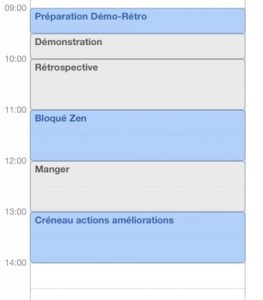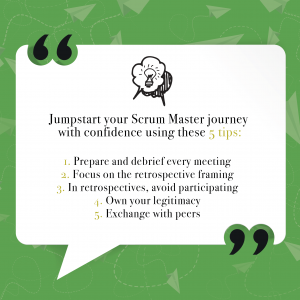Scrum Master: 5 keys to hit the ground running
Scrum Master is very different in nature than many enterprise roles., This can be very disorienting. As I care for people to start their Agile Journey with confidence, here are on top of my head 5 tips for Scrum Masters to get started.
As Agile methods spread within organisations, people from earlier agile teams are appointed Scrum Masters for new teams, often without much training. After practicing Scrum for a year or two with a team, it seems easy enough, right? Just replicate what you’ve seen, and voilà. Sadly, it’s never that simple.
The catch is, this role is usually very remote from one’s existing skill set. Plus, every team is different.
As soon as you start, you quickly realize that there are details, aspects, and mechanisms that you don’t yet understand fully. And of course, your boss and your teammates are counting on you. No pressure.
Can you do it?
The short answer? Yes.
Before we begin, I must reassure you that anybody can become a Scrum Master – no matter what your background or job may be. Although a bit confusing at first, anybody who likes to learn will get the hang of it in no time.
1) Prepare and debrief all the ritual meetings
The rituals are already set in the team’s calendar: iteration planning; review + retrospective; stand-up meeting. But for the Scrum Master, a preparation time is necessary to deliver the best session:
- Mental Preparation: Approx 10 minutes:
Involves reviewing the flow of the meeting, recapping past workshops, and repeating the introductions you will make. Think about the delicate issues that could be tackled: you will need to keep energy up to stay on top of the fray during these times.
- Logistics: Approx 15 minutes:
Involves checking and adjusting technical points (room, projector, network, post-its, markers, etc.)

As the diagram shows, the best way to prepare for every appointment is to block it in your calendar rather than in your head: a 25-minute lead on the appointment you’re about to conduct, with an automatic repetition every consecutive meeting. This time is specifically useful for you to do everything before the meeting starts.
When the participants arrive at the meeting, they will find you already there,very confident and absolutely prepared. if you trust yourself, they will trust you.
Since we’re on the calendar topic ; some time after the meeting must always be blocked:
- Implementation of decisions: Approximately 1 hour during the half-day following the meeting.If decisions regarding the backlog or the team dashboard have been made, the easiest thing to do would be to implement them immediately. Same principle: Entry another entry in your calendar, 1 hour appointment, repetition at each iteration.
- Debriefing: 1 hour to 2 hours after the retrospective.
The role of facilitator is a tiresome one. You will tire out quickly at first – guaranteed. Staying above the fray & not getting caught up in the emotions of the group takes energy. A lot of it.. So avoid any complicated tasks in stride as you may not have the energy to do them. Save yourself for the heavy lifting. Your team needs you.
On average, the basic role of Scrum Master should take up around 30% of your time. During the remaining 70%, you will play the role of a teammate like any other. Remember,it’s simply a role, not a full-time position.
2) Focus on the retrospective frame, not its process
The simple notion of frame in facilitation theory is the one that helped me the most as a Scrum Master, explaining how meetings can run smoothly no matter their process.
Most meetings end up in disarray because we’re, well, humans. We get passionate. We digress. We get stuck in confronting opinions, or reversely, we comply with the group’s direction. Your role as a scrum master is to help keep the ship pointed in the right direction. It is your role to steer the conversation, not participate in it.
In order to do so, it is essential to set a frame at the start of the meeting. Essentially, it’s an agreement between the participants to make the most of their time spent together.

Introduce the session by recalling this agreement:
- The purpose of the meeting (check if there are other expectations if you have any doubts)
- The time allotted (ask if any have time constraints)
- Each participant and their roles (if it is the first time or if new ones are participating)
- The progress steps and the division of the time that you propose (check that everyone nods)
- Any other rules to be observed
After everyone has agreed with the frame, they will understand your facilitating interventions, and you can always circle back to it. If you notice that the participants do not react well to your interventions, it is most often because they do not understand their justification ; go back to the frame.
Examples:
- “I have to ask you to conclude quickly, otherwise the round table will last too long and we will not have time to discuss the points afterwards”
- “I suggest we get into this later his is the demo, we agreed that we would just be checking the user stories and not dig into any exploration”
- “Are you still on the subject of the meeting?”
If the participants react negatively, turn this back on them: “Do you want to take more time?”, or “Do you want to update the meeting agenda?”, “Do you want to interrupt the round table to talk about XXX? ”. As a facilitator you help them respect the frame for their own good, but that does not prevent it from being changed if everyone agrees.
Tip: do not be afraid if your meetings seem formal the first few times: fun will come after you get comfortable.
3) Do not get involved in discussions during retrospectives
The secret to succeed during your first facilitations is to stay out of discussions and have only one goal: steer the flow of the meeting (not what transpires within it). This first exercise is a bit extreme for first timers, but I can assure you, not participating is effective.

Getting into debates is usually every facilitator’s mistake and what you should be cautious about. Discussions have a way to drag you further and exhaust you, and soon you forget about your facilitator duty, leaving the flow of the meeting unsupervised.
Yes, it will be very difficult at first. Yes, you will have answers to some problems that the group brings up. But I must insist: DO NOT ENTER THE DEBATE.
Being a facilitator is like hosting a party: you don’t enjoy it much, but the guests do!
Instant advantage: by giving up participating, you hone your listening skills, develop your observation skills, and get a better understanding of the relationships and dynamics that shape your team.
4) Own your legitimacy
Often when starting out, we hesitate to adopt strict strategies from the getgo. How strict should we be? How direct are we expected to be?

The secret: this power, your teammates gave it to you. They agree that you must take action. They appointed you Scrum Master.
Once you understand this dynamic, you can ask them for help without putting your legitimacy into question
- ask what they want from you, in a meeting or over coffee with a colleague. Examples:
“I see that we have gone over 20 minutes; next time do you want me to be more strict on the watch?”
“When you slipped on the subject of the bug, you would have wanted me to cut you off?” - delegate certain tasks or responsibilities:
“Who wants to help me write down today’s decisions?”
“Mathieu, do you keep the time reminders?”, “Philippe, would you like to keep the dashboard up to date?”
Your teammates gave you a role and responsibilities, but they haven’t left you alone: don’t be afraid to ask for their help.
5) Exchange with peers
One last point too often forgotten: we often understand a situation better and what to do about it when we talk about it with someone. Talking with people outside your project (a Scrum Master, Agile coach, or a mentor) will make you step back and progress.
And of course, reach out and participate atto one of the many agile meetups. See you there?

Each Scrum Master brings a bit of their character to their team. Some bring a strong cohesion through their empathy, others bring a passion for metrics, some do document a lot, to each their own style.
Do you want to be a good Scrum Master? Be yourself. Do things your way, and develop your style.
TL;DR:

Tags: Agile, Agile Facilitator, Facilitation, Meeting
Learn the best practices from a professional coach.
I provide agile management and role training to deliver results, from startups to global enterprises.